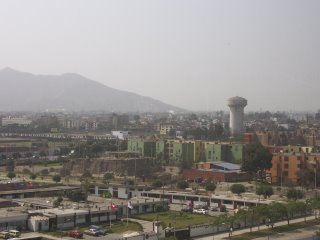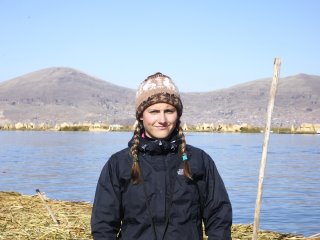Argentina (or: Why My Efforts to Become a Vegetarian Failed)
By the first moment Colleen and I arrived in Buenos Aires, I had already gotten the music from "Evita" stuck in my head and indeed the first thing I said to the taxi driver was to go to the Casa Rosada. As it turned out, the Plaza de Mayo where the building is located was close to our hostel and we returned there several times. I also ended up buying a book called "Santa Evita" about the reality and the myth about Eva Peron, which went well with my book about that OTHER famous figure in the musical, "The Motorcycle Diaries" by Che Guevara.

We stayed at a place called Milhouse Hostel, which had a fantastic word-of-mouth reputation despite not being in Lonely Planet that it certainly lived up to. Colleen definitely had some reluctance at staying in a hostel, but ended up partying more than I did. The people running the hostel were really suave, flamboyant Latin American types who were a lot of fun and organized walking tours and pub events. On the first day, we went on a walking tour through the upscale and historical Recoleta neighbourhood, which was followed by a walk through the Recoleta cemetery where of course Eva Peron is buried.

We followed that by looking at the Buenos Aires Museum of Latin American art, which was interesting and had stuff by all of the great Latin American masters including Frida Kahlo, etc. We had flown in overnight so decided not to go out that night, and the next day we went on another walking tour through the San Telmo neighbourhood.

This was where we saw a lot of the best architecture of Buenos Aires, and it wasn't for nothing that it reminded me of Paris, because that was what it was exactly modeled after. On the walls we saw lots of tango paraphernalia as Buenos Aires is indeed the world capital of tango culture and I became very entranced with the sexy, sultry music that played everywhere we walked. For lunch that day, we went to a restaurant that served the famous Argentine steak for which I sacrificed my long self-imposed red-meat fast. Let me tell you: it was worth it. It was the juiciest, most succulent steak I have ever tasted, and this is from someone who doesn't even especially like steak. North American steaks seem to be a lot tougher.

The tour ended at the Plaza de Mayo where we saw a protest of the mothers of the disappeared, who have been protesting for many years about the disappearance of people during the recent time in which Argentina was run fascist-style by the military. After China, it was kind of refreshing to see a protest, although there were still many police on hand to make sure that nothing too much happened. At the plaza I bought some Yerba Mate, which I have been completely hooked on for several years, and later that night I learned how to drink it Argentine-style. From here we went to the Museo de la Casa Rosada to learn more about Argentine political history (many, many presidents who ran for very short periods of time, and a large painting of the Perons) and then to an old, classic-style bar (of which there are many) with a guy from our hostel and we got to see a live tango show! Obviously I was very excited to watch some tango and the dances were interspersed with live versions of tango classics (including "Volver," which was central to Pedro Almodovar's latest movie). After this we returned to the hostel, rested for a bit, and were ready to leave at 2am to go to a club. I must say, it was the craziest club I have ever been to. There was a live show cross-dressers, dancers, and as much sexual innuendo as I've ever seen. We pushed our way to the front of the stage, where we were able to do shots of champagne from the dancers. At around 6am, innuendo gave way to a female stripper, all the women vanished and were replaced with scores of men taking pictures with their cell phones, and it was time to go back to the hostel.

The next day we were obviously a little bit tired and decided to take a bit easy, sleeping in and going down the street where for USD $1 the vendors destroyed about 12 oranges to produce a fresh cup of orange juice for you. We went to La Boca, which is the working class district that has buildings painted many different colours. We then went to the Museo de Evita to appease my Evita fixation that began when we entered the country, and the Museo des Belles Artes where we saw lots of classic paintings in a world-class collection.

From here, we took an overnight bus to Cordoba. This would have seemed a bit easy, except that our bus from Cordoba either did not come or did not have anything indicating that it was going to Cordoba, and found a way to leave without us. When we tried to board another bus with the same company, the driver took our tickets to let us on, only to change his mind and tell me to go to the office to change our tickets. I asked him to give me the full ticket back, instead of just the stub, but he said it wouldn't be a problem. It was, however, and even though I went running back to get the full tickets, I was too late. We then went back to the office where we argued with the company saleswoman for about half an hour. It was here that I got to use the full extent of my Spanish, such as "el conducteur VA con YO TICKET!" There were a couple of nice Argentine ladies who argued on our behalf, and I picked up such words as "turistas... no bueno impresion de Argentina." We ended up paying full price from another company. Fortunately, we still arrived at Cordoba on time, and took a day trip to Alta Gracia to see Che Guevara's childhood home. It was interesting to visit this place having been to Cuba, and on the way there a local woman told me that Fidel Castro had recently visited the house before he got sick; it was even because of his extensive travelling in South America that he started to fall ill.
From here we went around Cordoba, doing some shopping and seeing the university, which is the oldest in Argentina, before heading back to BA for another day of sightseeing and shopping, and then headed back home via George Bush International Airport (no joke) in Houston.






